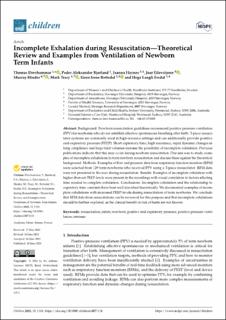| dc.contributor.author | Drevhammar, Thomas | |
| dc.contributor.author | Bjorland, Peder Aleksander | |
| dc.contributor.author | Haynes, Joanna Clare | |
| dc.contributor.author | Eilevstjønn, Joar | |
| dc.contributor.author | Hinder, Murray | |
| dc.contributor.author | Tracy, Mark | |
| dc.contributor.author | Rettedal, Siren | |
| dc.contributor.author | Ersdal, Hege Langli | |
| dc.date.accessioned | 2023-12-04T08:50:19Z | |
| dc.date.available | 2023-12-04T08:50:19Z | |
| dc.date.created | 2023-09-17T18:03:18Z | |
| dc.date.issued | 2023 | |
| dc.identifier.citation | Drevhammar, T., Bjorland, P. A., Haynes, J., Eilevstjønn, J., Hinder, M., Tracy, M., ... & Ersdal, H. L. (2023). Incomplete Exhalation during Resuscitation—Theoretical Review and Examples from Ventilation of Newborn Term Infants. Children, 10(7), 1118. | en_US |
| dc.identifier.issn | 2227-9067 | |
| dc.identifier.uri | https://hdl.handle.net/11250/3105733 | |
| dc.description.abstract | Background: Newborn resuscitation guidelines recommend positive pressure ventilation (PPV) for newborns who do not establish effective spontaneous breathing after birth. T-piece resuscitator systems are commonly used in high-resource settings and can additionally provide positive end-expiratory pressure (PEEP). Short expiratory time, high resistance, rapid dynamic changes in lung compliance and large tidal volumes increase the possibility of incomplete exhalation. Previous publications indicate that this may occur during newborn resuscitation. Our aim was to study examples of incomplete exhalations in term newborn resuscitation and discuss these against the theoretical background. Methods: Examples of flow and pressure data from respiratory function monitors (RFM) were selected from 129 term newborns who received PPV using a T-piece resuscitator. RFM data were not presented to the user during resuscitation. Results: Examples of incomplete exhalation with higher-than-set PEEP-levels were present in the recordings with visual correlation to factors affecting time needed to complete exhalation. Conclusions: Incomplete exhalation and the relationship to expiratory time constants have been well described theoretically. We documented examples of incomplete exhalations with increased PEEP-levels during resuscitation of term newborns. We conclude that RFM data from resuscitations can be reviewed for this purpose and that incomplete exhalations should be further explored, as the clinical benefit or risk of harm are not known. | en_US |
| dc.language.iso | eng | en_US |
| dc.publisher | MDPI | en_US |
| dc.rights | Navngivelse 4.0 Internasjonal | * |
| dc.rights.uri | http://creativecommons.org/licenses/by/4.0/deed.no | * |
| dc.title | Incomplete Exhalation during Resuscitation—Theoretical Review and Examples from Ventilation of Newborn Term Infants | en_US |
| dc.type | Peer reviewed | en_US |
| dc.type | Journal article | en_US |
| dc.description.version | publishedVersion | en_US |
| dc.rights.holder | © The Author(s) 2023 | en_US |
| dc.subject.nsi | VDP::Medisinske Fag: 700 | en_US |
| dc.source.volume | 10 | en_US |
| dc.source.journal | Children | en_US |
| dc.source.issue | 7 | en_US |
| dc.identifier.doi | 10.3390/children10071118 | |
| dc.identifier.cristin | 2175808 | |
| cristin.ispublished | true | |
| cristin.fulltext | original | |
| cristin.qualitycode | 1 | |

